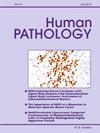Biological behavior of DCIS with or without microinvasion. Same and different
IF 2.6
2区 医学
Q2 PATHOLOGY
引用次数: 0
Abstract
Background
Ductal carcinoma in situ (DCIS) is a non-invasive type of breast cancer, detected mostly due to associated calcifications. Although non-invasive and primarily treated with surgical excision, recurrence as in situ or invasive form occurs in a substantial subset of DCIS patients. Microinvasion, defined as less than or equal to 1 mm invasive focus poses a diagnostic, biological and therapeutic dilemma, as the exact biological behavior of DCIS with or without microinvasion is controversially understood. In this retrospective study based on standardized pathology reports from a single center, we addressed the question if DCIS with or without microinvasive foci represents biologically one disease or two distinct entities.
Materials and methods
We identified 148 patients with surgically treated DCIS and complete clinico-pathological data and follow-up information, 126 of 148 (85.1 %) pure form, 22 of 148 (14.9 %) with microinvasive foci. Events in follow-up (in-situ, invasive recurrent disease, breast cancer related death) were correlated with the presence of microinvasive foci and with pathological parameters (DCIS size, nuclear grade, the presence of necrosis, margin status, biomarkers, hormone receptors and Ki67 index) and clinical information (therapy modalities). Overall time-to-event-probability (TTE) was assessed with Kaplan Meier curves.
Results
There was a total of 28 events (18.9 % of cohort). 12 of 148 (8.1 %) patients had recurrent DCIS, 16 of 148 (10.8 %) developed invasive breast cancer, 5 of 148 (3.4 %) patients died related to breast cancer in follow-up. DCIS with/without microinvasion did not differ significantly in TTE. There was a non-significant trend for worse 5-year breast cancer related death in DCIS with microinvasion. DCIS with microinvasion developed significantly more often in-situ or invasive recurrences in extensive disease (≥5 cm) (p = 0.040), with nuclear high grade (p = 0.045), with necrosis present (p = 0.045), with narrow resection margins (>1 mm) (p = 0.006), with younger age (≤50 years) in follow-up (p = 0.025) and in the absence of adjuvant radio- and/or endocrine therapy (p = 0.009, p = 0.034). No further factors such as calcification, positive margins, hormone receptor status had an impact on TTE on DCIS with or without microinvasive foci.
Conclusion
Our data shows that biological behavior of DCIS with microinvasive foci per se does not differ from pure DCIS in TTE. However, in-situ or invasive recurrences (total or ipsilateral) occur more often in microinvasive DCIS with extensive disease, with nuclear high grade, present necrosis, with narrow resection margins and in younger age in follow-up. These data warrant for further studies to understand the biology of DCIS with microinvasion and to evaluate specific therapy options different from pure DCIS potentially involving adjuvant modalities.
有无微侵的DCIS生物学行为。相同和不同。
背景:导管原位癌(Ductal carcinoma in situ, DCIS)是一种非侵袭性乳腺癌,主要因其钙化而被发现。尽管非侵入性且主要以手术切除治疗,但原位或侵入性复发发生在相当一部分DCIS患者中。微浸润,定义为小于或等于1mm的浸润灶,给诊断、生物学和治疗带来了困境,因为有或没有微浸润的DCIS的确切生物学行为尚存在争议。在这项基于单一中心标准化病理报告的回顾性研究中,我们解决了DCIS伴或不伴微创灶在生物学上代表一种疾病还是两种不同实体的问题。材料和方法:148例经手术治疗的DCIS患者有完整的临床病理资料和随访信息,148例中126例(85.1%)为纯灶,22例(14.9%)为微创灶。随访事件(原位、侵袭性复发疾病、乳腺癌相关死亡)与微创灶的存在、病理参数(DCIS大小、核分级、坏死的存在、边缘状态、生物标志物、激素受体和Ki67指数)和临床信息(治疗方式)相关。总体时间到事件概率(TTE)用Kaplan Meier曲线评估。结果:共发生28起事件(占队列的18.9%)。148例患者中有12例(8.1%)DCIS复发,16例(10.8%)发生浸润性乳腺癌,5例(3.4%)因乳腺癌死亡。DCIS伴/不伴微侵在TTE中无显著差异。伴有微侵的DCIS患者5年乳腺癌相关死亡的趋势不明显。伴有微侵的DCIS在广泛病变(≥5cm) (p=0.040)、核高分级(p=0.045)、存在坏死(p=0.045)、切缘狭窄(bbb1mm) (p= 0.006)、随访年龄较小(≤50岁)(p= 0.025)和缺乏辅助放射和/或内分泌治疗(p=0.009, p= 0.034)时更容易发生原位或侵袭性复发。钙化、边缘阳性、激素受体状态等其他因素对有无微创灶DCIS的TTE无影响。结论:我们的数据显示,具有微创病灶的DCIS本身的生物学行为与TTE中单纯的DCIS没有区别。然而,原位或侵袭性复发(全部或同侧)更常发生在病变广泛、核高分级、存在坏死、切除边缘狭窄和随访年龄较小的微创DCIS中。这些数据为进一步的研究提供了依据,以了解DCIS的微侵袭生物学,并评估不同于单纯DCIS的特定治疗方案,可能涉及辅助方式。
本文章由计算机程序翻译,如有差异,请以英文原文为准。
求助全文
约1分钟内获得全文
求助全文
来源期刊

Human pathology
医学-病理学
CiteScore
5.30
自引率
6.10%
发文量
206
审稿时长
21 days
期刊介绍:
Human Pathology is designed to bring information of clinicopathologic significance to human disease to the laboratory and clinical physician. It presents information drawn from morphologic and clinical laboratory studies with direct relevance to the understanding of human diseases. Papers published concern morphologic and clinicopathologic observations, reviews of diseases, analyses of problems in pathology, significant collections of case material and advances in concepts or techniques of value in the analysis and diagnosis of disease. Theoretical and experimental pathology and molecular biology pertinent to human disease are included. This critical journal is well illustrated with exceptional reproductions of photomicrographs and microscopic anatomy.
 求助内容:
求助内容: 应助结果提醒方式:
应助结果提醒方式:


